Fluvisol permeability estimation using soil water content variability
DOI:
https://doi.org/10.15233/gfz.2017.34.9Keywords:
soil permeability, unsaturated hydraulic conductivity, water content, well field KosnicaAbstract
The use of unsaturated hydraulic conductivity can help to define soil permeability, i.e. can contribute to the estimation of water percolation through unsaturated zone. The goal of this paper was the estimation of soil permeability at the location of case study profile Kosnica, situated in the alluvial plain of the Zagreb aquifer, Croatia, based on the variation in soil water content. Zagreb aquifer represents the only source of potable water for inhabitants of the City of Zagreb and Zagreb County. The thickness of unsaturated zone of the Zagreb aquifer varies from 8 meters in NW part to 2 meters in SE part. The unsaturated hydraulic conductivity values were calculated according to the granulometric composition of soil horizons and with optimized soil parameters. Variation in unsaturated hydraulic conductivity showed that the upper part of the soil profile was generally permeable throughout the 2011/2012 hydrologic year. The unsaturated hydraulic conductivity calculated with optimized soil parameters gave the highest values, always greater than 1E-9 m/s. Even though the estimation of soil profile permeability would be more precise with measurements of water content and pressure head in each soil horizon, calculation performed in this manner can give the first insight in general estimation of the unsaturated hydraulic conductivity variability and related soil permeability.
Downloads
Published
Issue
Section
License
Copyright (c) 2021 Geofizika journal

This work is licensed under a Creative Commons Attribution-NonCommercial 4.0 International License.

